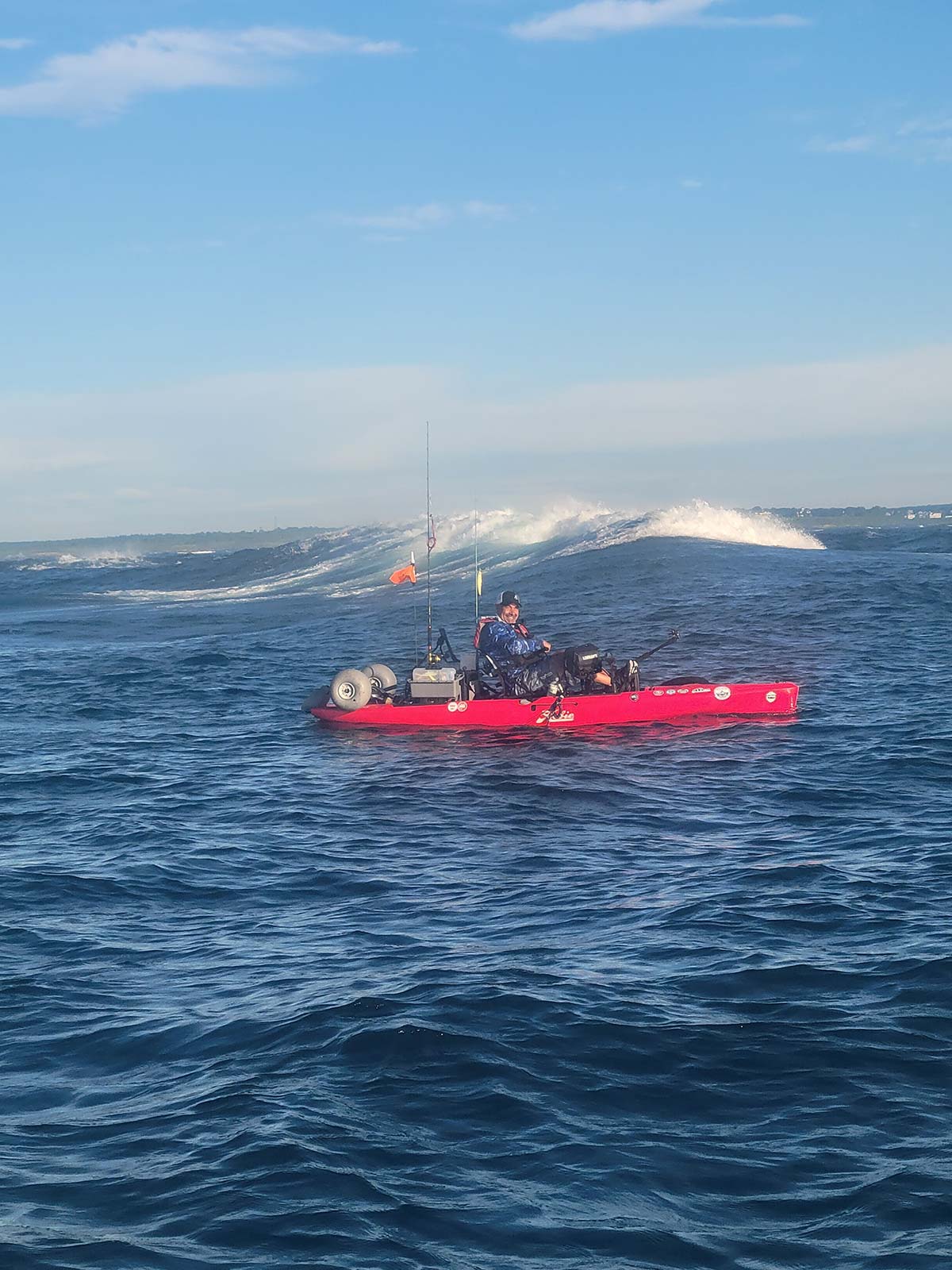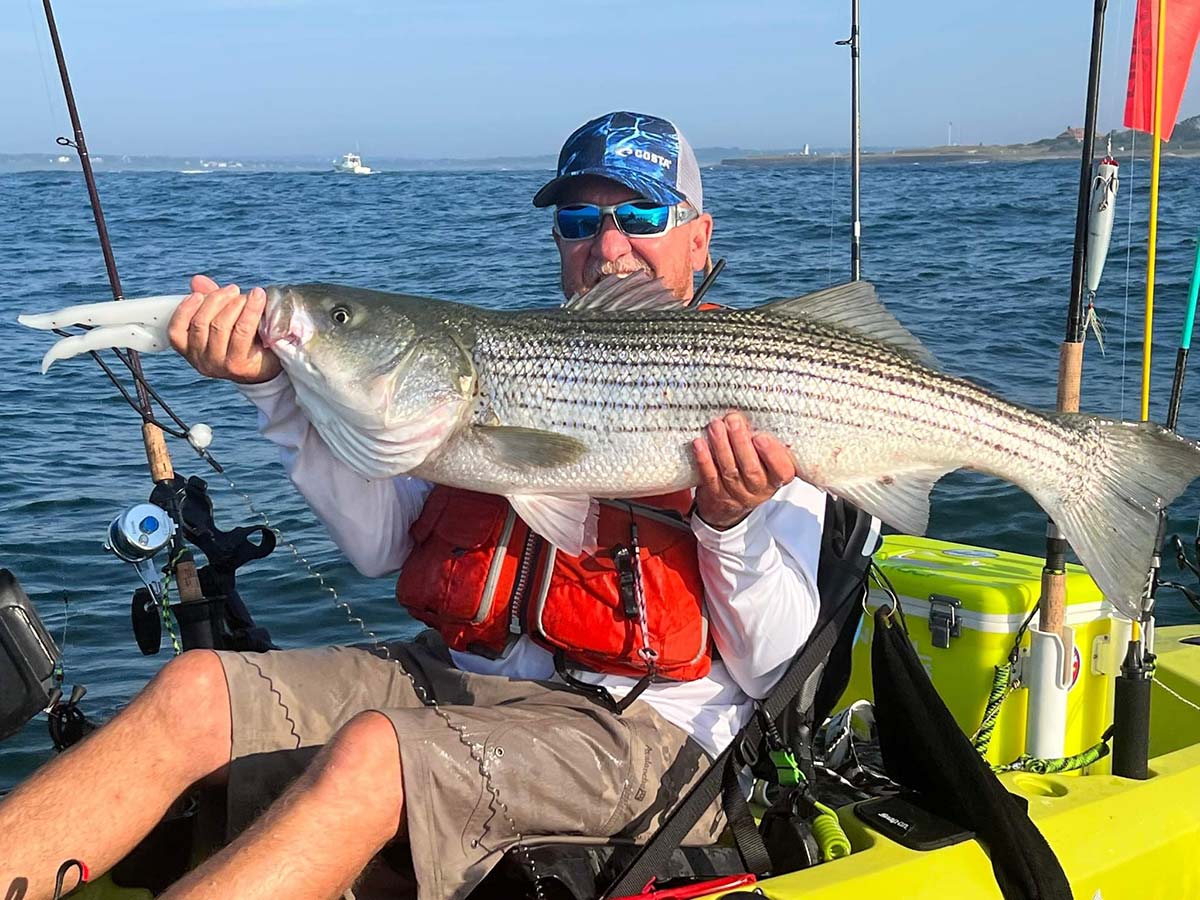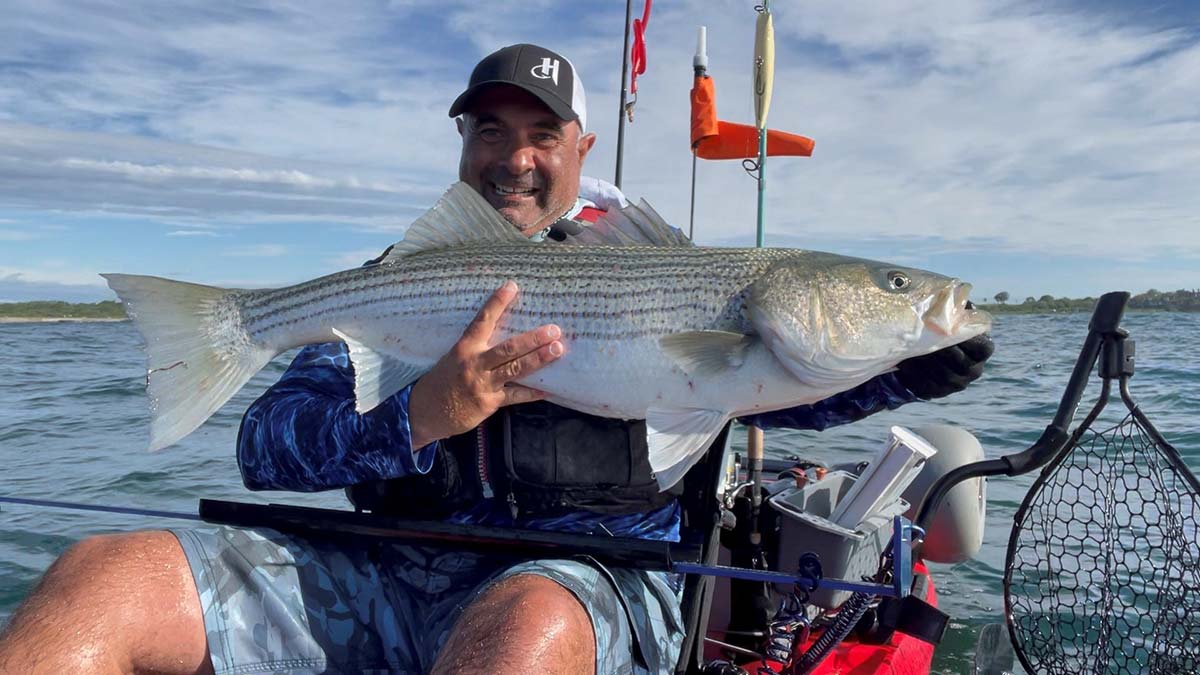
Striped bass love whitewater, the well-prepared kayaker will love it too.
I plan my weekend kayak excursions, many days in advance. I’m switching between phone apps daily, looking at The Weather Channel, Windy and Tides, to see what may lie ahead. All the while, I’m trying to make sense of the wind and waves to find a window when I can fish.
In the fall, checking these future forecasts can feel like a gut-punch, because Mother Nature is often unwilling to cooperate with my plans. I’m sure many of you have experienced this same phenomenon. The reality of the situation is, as long as you can find a safe place to launch, the fish don’t care about the weather and are often even more fired up thanks to the unsettled conditions. We all hear the stories about surfcasters crushing fish under whitewater conditions in the fall and, in many way, the same things could be said for targeting stripers in the kayak.
Making The Right Choice
“To launch, or not to launch,” is always the first question you should ask yourself when waking up on a day when the conditions might be described as ‘iffy at best’. Safety should always be your number one consideration when making a launch decision, because no ‘personal best striper’ is worth risking your life. Ever.
Being a member of the Ocean State Kayak Anglers Association (OSKAA), I can call upon a network of experienced kayakers who are willing to share their thoughts and, in some cases, real time observations about a possible launch location. On a sportier day I will almost never venture out on my own. If one or more experienced members of the group are willing to launch, then we can work together as a team surveying the conditions and having an added safety net should any extenuating circumstances arise. It’s also important to know your own personal limits and keep your ego in check. Once you are out there if the conditions are worse than you thought, or you do not feel safe or comfortable on the water, it’s better to pack up for another day than risk your life or your kayak and gear.

Be Prepared
It is also extremely important to make sure that you always have the key pieces of safety gear with you when launching on a rough water day. While most will launch with their mobile phone in a pocket or waterproof container, when waves are crashing over your hull and your hands are wet, it becomes nearly impossible to use. A marine grade handheld radio is a must in this case and will make it very easy for you to call for help or communicate with your team. Other key items that you must have for a trip in these conditions include a personal floatation device, a whistle, a well charged battery for your GPS / chart plotting device, first aid kit, flashing emergency strobe light, dry storage bag, flashlight, and extra food and water.
Regarding a rough water launch, I’d also advise to only do it in areas you have fished before and where you have studied maps in advance. On a typical rough water day, you will see breaks that you don’t see on calmer days, and the breaks that you know of will be larger than normal. Using Navionics or other such chart plotting technology on your GPS-enabled fishfinder will help you clearly locate where the breaks will likely be and where the safety zone will likely be as well. When you hook up with a fish in these turbulent areas it is critical to have your head on a swivel so you can make sure the fish is not pulling you towards danger, or that when you are landing and unhooking the fish that you are not drifting into a perilous situation.
Risk vs. Reward
There is a bit of risk and reward proposition when fishing the edges of rip lines or breaks, but often that’s where the larger fish are lurking. Rips over structure and breaks are a favorite spot for the bigger fish on whitewater days. Baitfish may find themselves caught up in the washing-machine-like action surrounding these areas setting up an easy scenario for powerful stripers to charge in and take advantage.
I prefer to troll a tube and live sandworm deeper near those breaks and throw larger surface plugs (if the wind allows) or heavier eel-like soft plastics near these turbulent locations. On the top of my list of favorite lures for fishing these conditions is a Butchie Built Custom Tube with live sandworm. If live sandworms are not available, a Fishbites Sandworm or Berkley Gulp Hollow Tube Sandworms (4 inch) will also work. I prefer a tube on these rougher days as if the wind is blowing, you can still get a tube into the strike zone while trolling.
In terms of weighted swimbaits, I prefer using Zinger Baits Bomba Shads (9 inch) on Zman TT Jig heads ranging from half- to 1-ounce. For surface plugs, if the wind allows, I always will have a Shimano Splash Walk or Game On Lures X-Walk topwater plug ready to go should the fish show themselves actively feeding on the surface.

Words Of Experience
I had the opportunity to share a Rhode Island rough water session with Noe Phommarath and Michael Pahlas earlier this year. We all caught fish well above slot size that day primarily fishing the tube and worm near structure with continually breaking water. We fished a spot we were all familiar with however as the wind picked up later in the morning the conditions continued to deteriorate eventually forcing us off the water.
When I asked Noe for his insights on rough water kayak fishing, he started with a simple but very meaningful proverb “I was always told if you’re going to fish in rough water, learn to be a kayaker first and a fisherman second.” The importance of knowing your kayak, how it operates, and the physical aspects of how to use it to stay clear of trouble is the name of the game. Noe added, “In rougher water, you must favor stability over speed all day. Sitting low in my Hobie Outback helps me remain balanced and centered in more unpredictable water.”
Noe also warned that during moon tides or after a storm, the effects of breaks or rips are multiplied, making them times more perilous; so always know the lunar and surf conditions prior to launch. Regarding fishing approaches and gear for rough water conditions Noe said, “I don’t really change my technique much in more difficult conditions. If it’s too windy or choppy I probably won’t be throwing topwater plugs and will favor bucktails or jigs. The key is using heavier lures versus lighter when the wind and water conditions call for it.”
When I asked Noe about how he decides where and when to launch on rougher days he said, “The Windfinder mobile app is one of the best you can get. It clearly displays predicted wind speed and wave height which can be extremely helpful in deciding where to fish and how.”
In catching up with The Kayak Center of RI fishing team member Michael Pahlas, he added, “When fishing rough water, whether you are a novice or veteran at kayak fishing, paying attention to your surroundings is critical. While the sport – in general – is a calming, peaceful, getaway there are situations that arise that a kayak fisherman must be aware of. Current, wind, tides, and even boat traffic can make turbulent water even rougher. The contour of the bottom and depth of water will create breaks and have a dramatic effect on the surface.”
Michael, who caught multiple big fish the day we were out, closed by saying “Even when you think you are done and ready to land, don’t let down your guard.” Michael reminded me of an incident he experienced years ago when attempting to beach his kayak on a lumpy day and misjudged how rough the landing spot was and ended up capsizing his kayak. He admits that he was lucky only gear was damaged.
With the changing weather patterns, we have seen over recent years, kayak fishing in rougher water will likely become a more frequent event. Fortune favors the prepared, and this is certainly the case with rough water kayak fishing. By strategizing in advance, rallying an experienced team, and bringing the right gear you can certainly increase your chances of success and make a rough water session something you can add to your kayak fishing repertoire.





